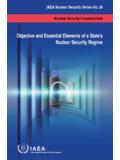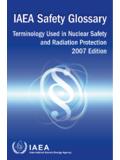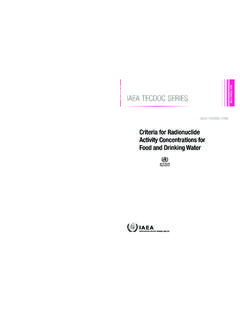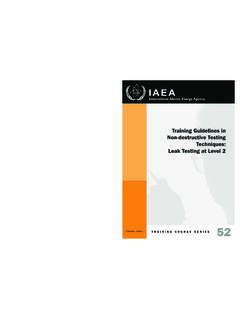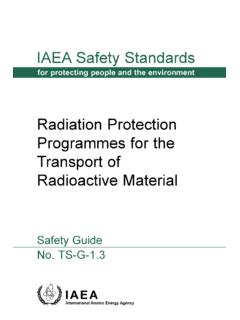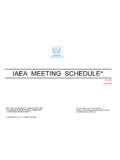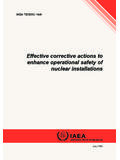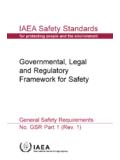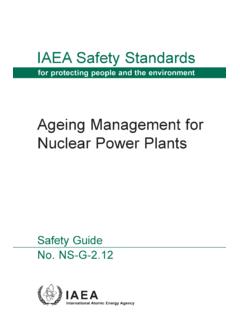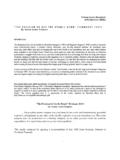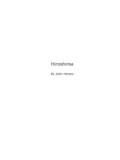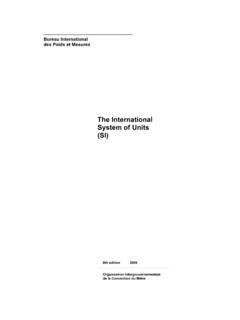Transcription of DES SOURCES RADIOACTIVES КОДЕКС ... - www …
1 Code of Conduct on the Safety and Security of Radioactive 2003-12-19 09:10 Page 1 CODE OF CONDUCT ON THE SAFETY AND SECURITY OF RADIOACTIVE SOURCES CODE DE CONDUITE SUR LA S RET ET LA S CURIT DES SOURCES RADIOACTIVES C DIGO DE CONDUCTASOBRE SEGURIDAD TECNOL GICA Y F SICA DE LAS FUENTES RADIACTIVAS КОДЕКС ПОВЕДЕНИЯ ПО ОБЕСПЕЧЕНИЮ БЕЗОПАСНОСТИ И СОХРАННОСТИ РАДИОАКТИВНЫХ ИСТОЧНИКОВ CODE OF CONDUCT ON THE SAFETY AND SECURITY OF RADIOACTIVE SOURCES CODE DE CONDUITE SUR LA S RET ET LA S CURIT DES SOURCES RADIOACTIVES C DIGO DE CONDUCTASOBRE SEGURIDAD TECNOL GICA Y F SICA DE LAS FUENTES RADIACTIVAS КОДЕКС ПОВЕДЕНИЯ ПО ОБЕСПЕЧЕНИЮ БЕЗОПАСНОСТИ И СОХРАННОСТИ РАДИОАКТИВНЫХ ИСТОЧНИКОВ The originating Divisions of this publication in the IAEA were.
2 Division of Radiation and Waste Safety Legal Division International atomic Energy Agency Wagramer Strasse 5 Box 100 A-1400 Vienna, Austria CODE OF CONDUCT ON THE SAFETY AND SECURITY OF RADIOACTIVE SOURCES IAEA, VIENNA, 2004 IAEA/CODEOC/2004 IAEA, 2004 Printed by the IAEA in Austria January 2004 CODE OF CONDUCT ON THE SAFETY AND SECURITY OF RADIOACTIVE SOURCES INTERNATIONAL atomic ENERGY AGENCY _____ FOREWORD This Code of Conduct on the Safety and Security of Radioactive SOURCES was approved by the Board of Governors of the International atomic Energy Agency (IAEA) on 8 September 2003. It replaces the version published (with the symbol IAEA/CODEOC/2001) by the IAEA in March 2001. It reflects the important findings produced by the International Conference on Security of Radioactive SOURCES held in Vienna in March 2003 (the Hofburg Conference).
3 The G-8 annual summit held in Evian, France, in June 2003 issued a statement on non-proliferation of weapons of mass destruction securing radioactive SOURCES in which it encouraged all countries to strengthen controls on radioactive SOURCES and observe the Code of The Code of Conduct marks the culmination of developments and efforts spanning the past several years that are described below. The International Conference on the Safety of Radiation SOURCES and Security of Radioactive Materials held in Dijon, France, in September 1998 produced findings in the light of which the IAEA s Board of Governors requested the Secretariat to the IAEA to prepare an action plan. The action plan subsequently approved by the Board of Governors, in September 1999, called for the development of a Code of Conduct on the Safety and Security of Radioactive SOURCES .
4 In September 2000, the Board of Governors took note of the Code, and the General Conference invited IAEA Member States to take note of it and to consider, as appropriate, means of ensuring its wide application. International support for the Code was soon expressed at the International Conference of National Regulatory Authorities with Competence in the Safety of Radiation SOURCES and the Security of Radioactive Material held in Buenos Aires in December 2000. The Buenos Aires Conference called upon States to provide for the application and implementation of the 1 The G-8 also issued an action plan in which it lent its political support to the IAEA in connection with the Code. 2 Further support for the Code was expressed in April 2001 by the First Africa Workshop on the Establishment of a Legal Framework Governing Radiation Protection, the Safety of Radiation SOURCES and the Safe Management of Radioactive Waste.
5 The workshop, held in Addis Ababa, adopted a Common Position in which it called upon the IAEA to create a forum for African countries to consider the Code of Conduct on the Safety and Security of Radioactive Materials, and give it a legally binding effect so that the safe and peaceful use of nuclear technology is not compromised . In 2001, the Secretariat, taking into account inter alia the major findings of the Buenos Aires Conference and the Common Position 2, produced a Revised Action Plan for the Safety and Security of Radiation SOURCES (the Revised Action Plan, approved by the Board of Governors on 10 September 2001). The Revised Action Plan called for the Secretariat to consult Member States on their experience in implementing the Code. The effectiveness of the Code was therefore reviewed at a meeting of technical and legal experts in August 2002.
6 At that meeting, the Code s provisions relating to the security of SOURCES were strengthened in the light of the events of 11 September 2001 and consensus was reached on a number of previously unresolved issues. It was recognized that further work was needed, however, especially in relation to the scope of the Code. A draft revised Code was made available to the Board of Governors and the General Conference in an IAEA document issued in August 2002. At a second meeting of technical and legal experts, held in March 2003, changes were made to some of the definitions in the Code and language encouraging the harmonization of the formats of national registers of radioactive SOURCES was added. Also, progress was made towards defining the scope of the Code and with regard to the inclusion of provisions relating to import and export controls.
7 As final consensus was not reached, however, the experts agreed that the resulting text should be circulated to all IAEA Member States for comment. Besides being circulated to all IAEA Member States, the text was made available to the Hofburg Conference. The Findings of the Conference s President included a recommendation that States make a concerted effort to follow the principles contained in the Code, which was currently being revised. Finally, at a third meeting of technical and legal experts, held in July 2003, consensus was reached on the scope of the revised Code and on the revised Code s text. On 19 September 2003, following approval of the revised Code by the Board of Governors, the General Conference, having welcomed the Board s decision, urged each State to write to the Director General stating: that it fully supports and endorses the IAEA s efforts to enhance the safety and security of radioactive SOURCES ; and that it is working towards following the guidance contained in the revised Code.
8 In addition, it requested the Director General, subject to the availability of resources, to compile, maintain and publish a list of States that make a political commitment by writing to him as urged by the General Conference. Although the vast majority of radioactive SOURCES used around the world are managed safely and securely, and bring many benefits to humankind, accidents involving radioactive SOURCES have occurred, some with serious even fatal consequences, and in the 1990s there was growing concern about radioactive SOURCES that for one reason or another were not subject to regulatory control or over which regulatory control had been lost. The IAEA Secretariat expects that implementation of this Code of Conduct will help national authorities to ensure that radioactive SOURCES are used within an appropriate framework of radiation safety and security.
9 1 THE IAEA S MEMBER STATES Noting that radioactive SOURCES are used throughout the world for a wide variety of beneficial purposes, in industry, medicine, research, agriculture and education, Aware that the use of these radioactive SOURCES involves risks due to potential radiation exposure, Recognizing the need to protect individuals, society and the environment from the harmful effects of possible accidents and malicious acts involving radioactive SOURCES , Noting that ineffective, interrupted or sporadic regulatory or management control of radioactive SOURCES has led to serious accidents, or malicious acts, or to the existence of orphan SOURCES , Aware that the risks arising from such incidents must be minimized and protected against through the application of appropriate radiation safety and security standards, Recognizing the importance of fostering a safety and security culture in all organizations and among all individuals engaged in the regulatory control or the management of radioactive SOURCES , Recognizing the need for effective and continuous regulatory control, in particular to reduce the vulnerability of radioactive SOURCES during transfers, within and between States, Recognizing that States should take due care in authorizing exports, particularly because a number of States may lack appropriate infrastructure for the safe management and secure protection of radioactive SOURCES , and that States should make efforts to harmonize their systems of export control of radioactive SOURCES , Recognizing the need for technical facilities, including appropriate equipment and qualified staff.
10 To ensure the safe management and secure protection of radioactive SOURCES , Noting that the International Basic Safety Standards for Protection against Ionizing Radiation and for the Safety of Radiation SOURCES contain recommendations for protection against exposure to ionizing radiation and for the safety and security of radioactive SOURCES , 2 Recalling the IAEA s Safety Requirements document on Legal and Governmental Infrastructure for Nuclear, Radiation, Radioactive Waste and Transport Safety, Taking account of the provisions of the Convention on Early Notification of a Nuclear Accident (1986) and of the provisions of the Convention on Assistance in the Case of Nuclear Accident or Radiological Emergency (1986), Taking account of the provisions of the Joint Convention on the Safety of Spent Fuel Management and on the Safety of Radioactive Waste Management (1997)
